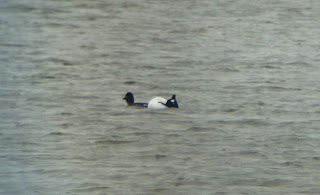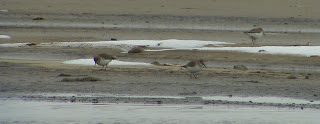 |
| Gulls over The Patch |
 |
| Gulls along the shoreline |
I was leading a walk for my local RSPB Group this weekend, but as I left home on Saturday morning for the drive to Dungeness I had to question the sense. It was -7.5 degrees, and the thought of standing on the shingle ridge scanning the patch for vagrant gulls made me shiver. However, these things have to be done, and as the sun came out as I joined the M20 I began to feel a little more optimistic about the prospects - even though the temperature had sunk to -8.5!
Along the A259 the trees and bushes were white with hoar frost and the sun shining on them created a magical scene. Narnia had nothing on this!
At the lighthouse the car park was icy but driveable. The temperature was -5.5 - positively balmy after the journey down.
The sea was flat-calm and with the sun out, this is probably the only time in 30 years of visiting that there was no wind and it almost felt warm. Common gull, herring gull, lesser black-backed and great black-backed were packed onto the shoreline looking like a foamy edge. A huge number of lesser black-backed also floated on the patch - again, a sight I have not seen for years, most of the gulls are usually in the air. Red-throated divers flew past, about a dozen in all and cormorants were also sighted. Great-crested grebe were bobbing about on the water.
 |
| Bittern |
Some people were starting to feel the cold so we moved on to the moat to see if anything was sheltering in the scrub and as we walked we started to thaw out, the feeling returning to our fingers and toes. As most of the bird reports were centered around Long Pits and the trapping area we broke with tradition and strode out for potential firecrest and woodcock. A nice walk to warm us up, but not a bird in sight.
 |
| Mallard, Teal and Water Rail |
On the way to the RSPB reserve a few of us stopped to scan the gulls near the fishing boats to try to find the glaucous gull which had taken up residence a couple of years ago - no luck there either. Moving on to the ARC pits, and just as I was starting to think that the day would be a bit of a damp squid, we found large numbers of wigeon, pochard, gadwall, shelduck and coot.
A quick stop at the reserve entrance and John, Pauline and I easily found tree sparrows, lots of them sitting in bramble showing really well in the sunlight.
Lunch at the reserve centre, with more tree sparrow, reed bunting, great tit and blue tit taking advantage of the feeders. A moorhen pecked around below.
 |
| Pintail |
We had arranged to meet up for the afternoon session at 1.45 pm, about 10 minutes before we were told that a male smew was showing well in front of one of the hides, so I suggested we start off there. Unfortunately a few folk had already gone through the centre, but the rest of us had good, if a little distant, views of the male and a couple of females. In the nearer pool several female goosanders were seen with one smartly plumaged male. Long-tailed duck came next and as we finally re-grouped a male sparrowhawk was seen sitting in the sun low in a bramble just feet from the hide. We also had superb views of bittern which was standing opposite the hide on the edge of the reed - having had rather difficult views of bittern at Sevenoaks, this one stood out so clearly, it is hard to imagine how cryptic they can be.
We continued around the reserve towards Denge Marsh Hide, with two female and a male marsh harriers going overhead, a bittern flew across the reed bed twice whilst we were in Christmas Dell Hide. I had a bit of telescope trouble when I tried to twist the telescope around to let a small boy look at the ducks, but I eventually managed to find the birds for him. His enthusiasm and joy was a real boost to a cold day. His list had previously held "ducks" and we managed to do mallard, teal, coot and little grebe, his explorers binoculars had obviously let him down on the clarity front previously!
 |
| Snow on the pool edge |
From Denge marsh there were several swans, all of the mute variety, a large number of pintail were upending as they fed, greylag, bearded tit and more wigeon were also present.
From the viewpoint we scanned the greylags in a distant field, but again only mute swans and one brent goose were present. A female marsh harrier flew in and perched on the side of a dyke looking impressive against the geese.
 |
| Sunset over Denge |
We finally returned to the car park, flushing a snipe on the way, then it was home for some and off to Icklesham for me - dinner with friends awaited me. The sunset along the coast road was superb with a red ball of fire reflecting in the water.

































